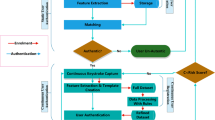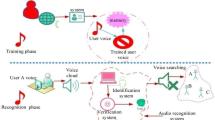Abstract
Biometric authentication has advantages over traditional authentication based on passwords or pin number (PIN) in that it is based on the user's inherent characteristics which is not easily stolen or lost. Keystroke dynamics and mouse dynamics are biometrics that study the behavior patterns of human–computer interaction (HCI). Personal keystroke pattern and mouse-movement pattern are difficult to imitate and can, therefore, be used for personal identity authentication. Keystrokes and mouse movements can potentially authenticate users without affecting the use of computers and other devices to improve system security. In real environments, authentication methods that fuse keystroke dynamics and mouse dynamics are less accurate. In this paper, a new method of user authentication using complex real-environment HCI data is presented, which is called authentication adaptation network (AAN). In this method, heterogeneous domain adaptation (HDA) method is used for user authentication based on keystroke dynamics and mouse dynamics for the first time. All representative time windows and dimensionality reduction targets of keystroke dynamics features are compared to determine the parameters of AAN to ensure the robustness of the algorithm, and the effectiveness of the algorithm is demonstrated by validation experiments and comparison with the methods proposed in previous studies. Finally, experiments using the collected real-environment HCI dataset obtained 89.22% user authentication accuracy, which indicate that the proposed method achieves an encouraging performance.












Similar content being viewed by others
References
Matyas, V., Riha, Z.: Toward reliable user authentication through biometrics. IEEE Secur. Priv. 1, 45–49 (2003). https://doi.org/10.1109/MSECP.2003.1203221
Teh, P.S., Teoh, A.B.J., Yue, S.: A survey of keystroke dynamics biometrics. Sci. World J. 2013, 1–24 (2013). https://doi.org/10.1155/2013/408280
Cai, Z., Shen, C., Guan, X.: Mitigating behavioral variability for mouse dynamics: a dimensionality-reduction-based approach. IEEE Trans. Human-Mach. Syst. 44, 244–255 (2014). https://doi.org/10.1109/THMS.2014.2302371
Çeker, H., Upadhyaya, S.: User authentication with keystroke dynamics in long-text data. In: 2016 IEEE 8th international conference on biometrics theory, applications and systems (BTAS), pp 1–6, (2016)
Alsultan, A., Warwick, K., Wei, H.: Improving the performance of free-text keystroke dynamics authentication by fusion. Appl. Soft Comput. 70, 1024–1033 (2018). https://doi.org/10.1016/j.asoc.2017.11.018
Huang, J., Hou, D., Schuckers, S., Hou, Z.: Effect of data size on performance of free-text keystroke authentication. In: IEEE international conference on identity, security and behavior analysis (ISBA 2015), pp. 1–7. IEEE, Hong Kong (2015)
Çeker, H., Upadhyaya, S., (2017) Sensitivity analysis in keystroke dynamics using convolutional neural networks. In: 2017 IEEE workshop on information forensics and security (WIFS). pp 1–6
Tewari, A., Verma, P.: An improved user identification based on keystroke-dynamics and transfer learning. WEB 19, 5369–5387 (2022). https://doi.org/10.14704/WEB/V19I1/WEB19360
Gamboa, H., Fred, A.: A behavioral biometric system based on human-computer interaction. In: Jain, A.K., Ratha, N.K. (eds.) Biometric technology for human identification, Orlando, FL, pp. 381–392 (2004)
Ahmed, A.A.E., Traore, I.: A new biometric technology based on mouse dynamics. IEEE Trans. Dependable Secur. Comput. 4, 165–179 (2007). https://doi.org/10.1109/TDSC.2007.70207
Kasprowski, P., Harezlak, K.: Fusion of eye movement and mouse dynamics for reliable behavioral biometrics. Pattern Anal. Applic. 21, 91–103 (2018). https://doi.org/10.1007/s10044-016-0568-5
Chong, P., Elovici, Y., Binder, A.: User authentication based on mouse dynamics using deep neural networks: a comprehensive study. IEEE Trans. Inform. Forensic Secur. 15, 1086–1101 (2020). https://doi.org/10.1109/TIFS.2019.2930429
Mondal, S., Bours, P.: Combining keystroke and mouse dynamics for continuous user authentication and identification. In: 2016 IEEE international conference on identity, security and behavior analysis (ISBA), pp 1–8, IEEE, Sendai, (2016)
An examination of user behavior for user re-authentication. In: Guide books. https://dl.acm.org/doi/abs/https://doi.org/10.5555/1368529. Accessed 6 June 2022
Peterson KOB and JSO and GL User identification and authentication using multi-modal behavioral biometrics | EndNote Click. https://click.endnote.com/viewer?doi=10.1016%2Fj.cose.2014.03.005&token=WzI4MTA5MDUsIjEwLjEwMTYvai5jb3NlLjIwMTQuMDMuMDA1Il0.5i_tWpM2Ucag7vA5yMnIayfc9UU. Accessed 15 May 2022
Mondal, S., Bours, P.: A study on continuous authentication using a combination of keystroke and mouse biometrics. Neurocomputing (2016). https://doi.org/10.1016/j.neucom.2016.11.031
Lv, H., Wang, W.-Y.: Biologic verification based on pressure sensor keyboards and classifier fusion techniques. IEEE Trans. Consumer Electron. 52, 1057–1063 (2006). https://doi.org/10.1109/TCE.2006.1706507
Rahman, A., Chowdhury, M.E.H., Khandakar, A., et al.: Multimodal EEG and keystroke dynamics based biometric system using machine learning algorithms. IEEE Access 9, 94625–94643 (2021). https://doi.org/10.1109/ACCESS.2021.3092840
Panasiuk, P., Dąbrowski, M., Saeed, K.: Keystroke dynamics and face image fusion as a method of identification accuracy improvement. In: Chaki, R., Saeed, K., Cortesi, A., Chaki, N. (eds.) Advanced computing and systems for security, pp. 187–196. Springer Singapore, Singapore (2017)
Wesołowski, T.E., Doroz, R., Wrobel, K., Safaverdi, H.: Keystroke dynamics and finger knuckle imaging fusion for continuous user verification. In: Saeed, K., Homenda, W., Chaki, R. (eds.) computer information systems and industrial management, pp. 141–152. Springer International Publishing, Cham (2017)
Singh, M., Singh, R., Ross, A.: A comprehensive overview of biometric fusion. Inform. Fusion (2019). https://doi.org/10.1016/j.inffus.2018.12.003
Liu, F., Zhang, G., Lu, J.: Heterogeneous domain adaptation: an unsupervised approach. IEEE Trans Neural Netw Learning Syst 31, 5588–5602 (2020). https://doi.org/10.1109/TNNLS.2020.2973293
Sharif, M., Raza, M., Shah, J.H., et al.: An overview of biometrics methods. In: Singh, A.K., Mohan, A. (eds.) Handbook of multimedia information security: techniques and applications, pp. 15–35. Springer International Publishing, Cham (2019)
Dharavath, K., Talukdar, F.A., Laskar, R.H.: Study on biometric authentication systems, challenges and future trends: A review. In: 2013 IEEE international conference on computational intelligence and computing research, pp 1–7, IEEE, Enathi, Tamilnadu, India, (2013)
Jeong, J., Zolotavkin, Y., Doss, R.: Examining the current status and emerging trends in continuous authentication technologies through citation network analysis. ACM Comput. Surv. (2022). https://doi.org/10.1145/3533705
Gaines, R.S., Lisowski, W., Press, S.J., Shapiro, N.: Authentication by keystroke timing: some preliminary results. RAND Corporation (1980)
Pisani, P.H., Lorena, A.C.: A systematic review on keystroke dynamics. J Braz Comput Soc 19, 573–587 (2013). https://doi.org/10.1007/s13173-013-0117-7
Joyce, R., Gupta, G.: Identity authentication based on keystroke latencies. Commun ACM 33, 168–176 (1990). https://doi.org/10.1145/75577.75582
Ayotte, B., Banavar, M., Hou, D., Schuckers, S.: Fast free-text authentication via instance-based keystroke dynamics. IEEE Trans Biom Behav Identity Sci 2, 377–387 (2020). https://doi.org/10.1109/TBIOM.2020.3003988
Lu, X., Zhang, S., Hui, P., Lio, P.: Continuous authentication by free-text keystroke based on CNN and RNN. Comput. Secur. 96, 101861 (2020). https://doi.org/10.1016/j.cose.2020.101861
Everitt, R.A.J., McOwan, P.W.: Java-based internet biometric authentication system. IEEE Trans. Pattern Anal. Mach. Intell. 25, 1166–1172 (2003). https://doi.org/10.1109/TPAMI.2003.1227991
Shen, C., Cai, Z., Guan, X., et al.: User authentication through mouse dynamics. IEEE Trans. Inform. Forensic Secur. 8, 16–30 (2013). https://doi.org/10.1109/TIFS.2012.2223677
Shen, C., Cai, Z., Guan, X., Maxion, R.: Performance evaluation of anomaly-detection algorithms for mouse dynamics. Comput. Secur. 45, 156–171 (2014). https://doi.org/10.1016/j.cose.2014.05.002
Feher, C., Elovici, Y., Moskovitch, R., et al.: User identity verification via mouse dynamics. Inf. Sci. 201, 19–36 (2012). https://doi.org/10.1016/j.ins.2012.02.066
Shen, C., Cai, Z., Guan, X.: Continuous authentication for mouse dynamics: a pattern-growth approach. In: IEEE/IFIP international conference on dependable systems and networks (DSN 2012), pp 1–12, IEEE, Boston, MA, USA, (2012)
Ahmed, A.A.E, Traore, I.: Anomaly intrusion detection based on biometrics. In: Proceedings from the sixth annual IEEE systems, man and cybernetics (SMC) information assurance workshop, 2005, pp 452–453, IEEE, West Point, NY, USA, (2005)
Traore, I., Woungang, I., Obaidat, M.S., et al.: Combining mouse and keystroke dynamics biometrics for risk-based authentication in web environments. In: 2012 fourth international conference on digital home, pp 138–145, (2012)
Shimshon, T., Moskovitch, R., Rokach, L., Elovici, Y.: Clustering di-graphs for continuously verifying users according to their typing patterns. In: 2010 IEEE 26-th convention of electrical and electronics engineers in Israel, pp 000445–000449, (2010)
Gretton, A., Borgwardt, K.M., Rasch, M., et al.: A Kernel method for the two-sample-problem, 8, (2006)
Vapnik, V.N.: An overview of statistical learning theory. IEEE Trans. Neural Netw. 10, 988–999 (1999). https://doi.org/10.1109/72.788640
Salmeron-Majadas, S., Baker, R.S., Santos, O.C., Boticario, J.G.: A Machine learning approach to leverage individual keyboard and mouse interaction behavior from multiple users in real-world learning scenarios. IEEE Access 6, 39154–39179 (2018). https://doi.org/10.1109/ACCESS.2018.2854966
Kingma, D.P., Ba, J.: Adam: a method for stochastic optimization, (2017)
Giot, R., Rocha, A.: Siamese networks for static keystroke dynamics authentication. In: 2019 IEEE international workshop on information forensics and security (WIFS), pp 1–6, IEEE, Delft, Netherlands, (2019)
Yao, Y., Zhang, Y., Li, X., Ye, Y.: Heterogeneous domain adaptation via soft transfer network. In: Proceedings of the 27th ACM international conference on multimedia, pp 1578–1586, ACM, Nice France, (2019)
Day, O., Khoshgoftaar, T.M.: A survey on heterogeneous transfer learning. J. Big Data 4, 29 (2017). https://doi.org/10.1186/s40537-017-0089-0
Wang, X., Zheng, Q., Zheng, K., Wu, T.: User authentication method based on MKL for keystroke and mouse behavioral feature fusion. Secur. Commun. Netw. 2020, 1–14 (2020). https://doi.org/10.1155/2020/9282380
Chen, X., Zicheng, W., Yiguo, P., Jinqiao, S.: A continuous re-authentication approach using ensemble learning. Proc. Comput. Sci. 17, 870–878 (2013). https://doi.org/10.1016/j.procs.2013.05.111
Acknowledgements
This research was funded by Beijing Natural Science Foundation, China, Grant Number 4202002.
Funding
This research was funded by Beijing Natural Science Foundation, China, Grant Number 4202002.
Author information
Authors and Affiliations
Contributions
Yutong Shi and Xiujuan Wang wrote the manuscript text, Kangfeng Zheng and Siwei Cao collected the experimental data. All authors reviewed the manuscript.
Corresponding author
Ethics declarations
Conflict of interest
The authors declare no competing interests.
Additional information
Publisher's Note
Springer Nature remains neutral with regard to jurisdictional claims in published maps and institutional affiliations.
Rights and permissions
Springer Nature or its licensor holds exclusive rights to this article under a publishing agreement with the author(s) or other rightsholder(s); author self-archiving of the accepted manuscript version of this article is solely governed by the terms of such publishing agreement and applicable law.
About this article
Cite this article
Shi, Y., Wang, X., Zheng, K. et al. User authentication method based on keystroke dynamics and mouse dynamics using HDA. Multimedia Systems 29, 653–668 (2023). https://doi.org/10.1007/s00530-022-00997-5
Received:
Accepted:
Published:
Issue Date:
DOI: https://doi.org/10.1007/s00530-022-00997-5





